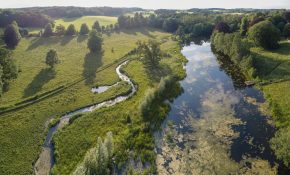Frogshall wetland in Norfolk – a silent hero?
Friday March 20th, 2020
Research led by NRT and RM Wetlands & Environment Ltd – and supported by researchers from University College London – has found that Integrated Constructed Wetlands (ICWs) can substantially reduce nutrient concentrations in effluent discharge from Sewage Treatment Works (STWs), and can also provide conservation benefits.
Frogshall, a 3-cell ICW located in North Norfolk, was created in 2014 to improve the quality of water discharging from Northrepps STW into the headwaters of the Mundesley Beck – a small but valuable chalk stream that eventually flows out to sea.
Since construction, the wetland has flourished, with various types of native aquatic and emergent plants becoming well-established including: yellow iris, greater pond sedge, bur-reed, water horsetail, common spike-rush, water mint and water speedwell.
To assess the effectiveness of the wetland at naturally improving final effluent water after it has discharged from the STW, water quality sampling was undertaken on a monthly basis pre and post intervention between 2013 and 2016. Results show that nutrient concentrations are significantly reduced at Frogshall’s outflow compared to the inflow, with reductions ranging from 62-80%. Nutrient concentrations were progressively reduced as flow travelled through each consecutive cell. Furthermore, avian monitoring recorded that bird species’ richness increased from 10 species pre-Frogshall creation, to 28 species in 2015, and 26 species in 2016. According to the British Trust for Ornithology’s (BTO) conservation categories (BTO, 2016), four of the new bird visitors were red listed species, and at least 5 of them were amber listed.
This research is hugely encouraging and reveals the tremendous potential for using wetlands as a solution to a challenging environmental problem, in addition to enhancing biodiversity through habitat creation. Furthermore, this is just the beginning of the story; this innovative approach pioneered by NRT has now been adopted by Anglian Water, and many more constructed wetlands are in the pipeline.
Find out more about Frogshall and the project here.
And read the full research paper here.








